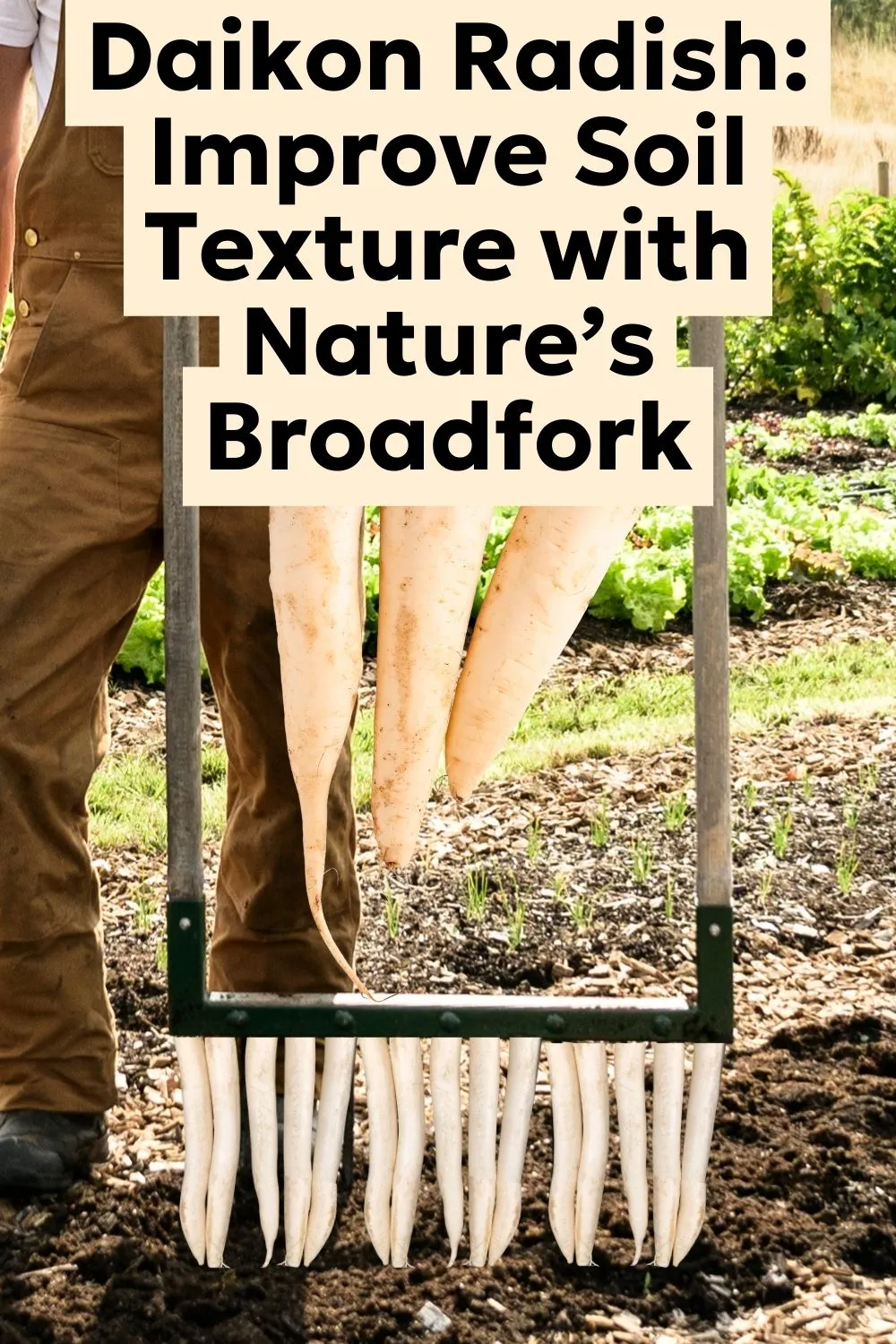
Be a Land Steward.
Sign up for Greenhouse Gases -
a weekly-ish newsletter that will teach you the science behind regenerative gardening, with action steps to help you make a difference in your backyard.

Sign up for Greenhouse Gases -
a weekly-ish newsletter that will teach you the science behind regenerative gardening, with action steps to help you make a difference in your backyard.

Sowing Time: Fall
Min Germination Temp: 45-50 degrees F
Germination Time: 3-10 Days
Cold Hardiness: Will winter kill at 20F
(Purdue University, Green Cover, San Diego Seed Company)
You’ll learn how daikon can:
Daikon radish has totally transformed my compacted heavy clay soil over the past few years. Read on to learn about this wonder of a cover crop.

Cover crops are:
Many of us don’t have naturally loamy, pest-free nutrient-rich soil with balanced water retention.
On the contrary, usually gardeners have at least a few things about their soil that they wish they could change or improve.
That’s where cover crops come in.
Worried about soil erosion? Plant a cover crop.
Got flooding? Plant a cover crop.
Want to prevent winter weed spread? You guessed it.
Need nutrients, organic matter or mulch? You know what to do.
Here’s what not to do, though: No herbicide is needed to kill back your cover crop.
I repeat: do not use herbicides to terminate your cover crops.
Instead, cut back or crimp the crop. This will break the plant at the stem. Leave any plant residue on or in the soil.
Here’s how to terminate a cover crop with a fence post.
Alternatively, trim it back to the soil with some clippers or scissors.
Tip: You can mix daikon with other cover crops, like cover or alfalfa, for a diversified soil boost.
Now that you’re caught up on the benefits of cover crops, learn why I’m forever singing the praises of daikon.

Solve Soil Compaction
With the ability to reach over a foot or more deep into the soil, daikon radish is what many farmers rely on to solve soil compaction issues. Home gardeners can do the same thing. Daikon creates holes in the soil that support improved soil aeration.
→ Bonus: The holes left behind from the decomposed daikon are perfect places to plant your upcoming seedlings.
Quick Decomposition
What’s so great about daikon is that at winter-kill or manual cut-back, the radish will break down in the soil quickly.
This means that you can direct seed or transplant your crops into the ground soon after without any competition from the cover crop.
Adds Organic Matter
Think of each daikon plant as the tines of a broadfork, but with the extra benefit of added organic matter.
Nitrogen
Radish is known to be skilled in the art of gathering nitrogen from deep in the layers of clay and loam soils.
If your radish doesn’t totally winter-kill, the nitrogen it recovers from your soil will be available to your next planting (UWM).
It’s important to note that since daikon radish breaks down quickly, the nitrogen is also released into the soil pretty soon after it dies back. Plant your next crop soon after the daikon is finished in order to be certain your crop can access the nutrients (Southern Cover Crops).
Potassium and Phosphorus
A document from the Natural Resources Conservation Service notes that daikon can also gather up phosphorus and potassium from the soil. These necessary nutrients will stay higher up in the soil bed to benefit the next crop.
Control winter + early spring weeds
Radish seeds germinate quickly and will grow to full size in under two months.
This is an asset for your soil - the leaf cover from the radish plant will shade the soil so pesky weed seeds can’t germinate (USDA).
Ohio State University also notes that radishes can be allopathic. That means its mere presence can halt the germination of weeds.
For best results, plant the daikon early in September (UMD).
Nematode Pest Control
Daikon radish contains glucosinate, a chemical that deters harmful nematodes.
Certain varieties of daikon, like “Sod Buster,” are specially bred to have high amounts of glucosinate. This can mean you’ll see even more nematode die-off (Southern Cover Crops Council).
The root knot nematode is one particular soil pest that daikon has been shown to decrease (ResearchGate).
Another nematode controlled by daikon is sugar beet nematode. Up to 75% of the nematode population can be eradicated with a radish crop! (NRCS USDA).
Brassica Clubroot
Brassica clubroot can impact many commonly grown plants in the veggie garden, like broccoli and cabbage. In 2001, a study found that daikon can prevent clubroot from impacting your main crops (UFL).
Fusarium Wilt
The same study that found that radish can decrease root knot nematode also proved that the plant residue can prevent fusarium wilt in plants. Fusarium wilt is especially detrimental to seedlings, so this is huge if you’re direct sowing your next crop (ResearchGate).
As the daikon radish decomposes in the soil, big air gaps remain (Territorial Seeds).
These gaps can turn into vessels for holding water, which can help reduce flooding issues and help subsequent crops access water easier (USDA).
If you’ve ever waited for in-ground beds to clear from flooding in the early spring, you know how that can impact the timing of your harvests. Planting daikon as a cover crop can help prevent this and encourage soils to dry sooner (UMD).
→ Fun Fact: After daikon blooms in the spring, it will form small pods that hold its seed. These pods are called siliques (NRCS USDA).

Since daikon is a cool season crop, it’s best to sow it after the heat of summer. When the average daily temperatures are around 50-60°F, that’s your cue to scatter the seeds (Purdue).
Prep
Remove all above ground annual crop material from the area. In cases where you had diseased plants, remove the plant in entirety and throw away. Otherwise, add the above ground material to your compost pile.
How Much Seed?
Around 1/2 pound of seed for every 1000 sq ft (Territorial Seed).
To help with visualizing this, 1000 square feet is:
Sow + Water
I have found that hand-scattering the seeds works really well, especially if done directly before a good rain event. Of course, you can water your seeded beds with drip irrigation or a regular hose.
I like to take a hoe and move the soil around just a little bit to help some soil to cover the seeds.
→ Reminder: Keeping the soil evenly moist after sowing ensures better seed sprouting
If you live in zone 6 and under, your radish cover crop will likely winter kill. Consistent winter temperatures below 20°F will do the trick.
If you live in zone 7 and up, your winters might not get cold enough for extended periods. If that’s the case, it’s likely your daikon won’t die back, or will die back temporarily above ground only to sprout back again once temperatures warm in late winter.
Not to worry though - daikon is relatively easy to
Give Daikon radish a try as a cover crop and experience its regenerative magic in your own garden! Between its ability to add organic matter to tough clay soil, to its pathogen and weed suppression qualities, daikon is a really winner.
As a bonus, it makes for an excellent addition to different fermented foods and stir fries, too!